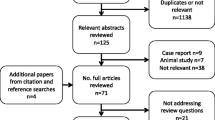Abstract
The two essential regulating mechanisms of the middle ear pressure are the trans-mucosal gas exchange in the middle ear and the ventilation function of the eustachian tube (ET). The physiological mechanism of these both functions is not yet clear. The purpose of this study was to evaluate the role of the ET pressure equilibrium function by ventilation scintigraphy with technetium-99m. The rabbit animal model in vivo was used to study the presence and role of the ventilation of the tympanic cavity via auditory tube. The obtained results did not show any ventilation function of the ET despite active opening by muscle movement. In our experience, ventilation scintigraphy with technetium-99m is not a reliable method to study the auditory tube pressure equilibrium function in physiological conditions.





Similar content being viewed by others
References
Ars B, Dirckx JJ (2003) Tubomanometry. In: Ars B (ed) Fibrocartilaginous eustachian tube—middle ear cleft. Kugler Publications, The Hague, The Netherlands, pp 151–158
Brenner W, Bohuslavizki KH, Kroker B, et al (1997) Ventilation scintigraphy of the middle ear. J Nucl Med 38:66–70
Celen Z, Kanlykama M, Yildrimin Bayazit A, Semih Mumbuc B, Zincirkeser S, Özbay E (1999) Scintigraphic evaluation of the eustachian tube function. Rev Laryngol Otol Rhinol 120:123–125
Elner A (1977) Quantitative studies of gas absorption from the normal middle ear. Acta Otolaryngol 83:25–28
Estève D, Dubreuil Ch, Della Vedova Cl, Normand B, Lavieille JP, Martin Ch (2001) Physiologie et physiopathologie de la fonction d’ouverture de la trompe auditive: Apports de la Tubomanométrie. JF ORL 50:233–241
Grontved A, Krogh HJ, Christensen PH, et al (1989) Monitoring middle ear pressure by tympanometry. Acta Otolaryngol (Stockh) 108:101–106
Hergils L, Magnuson B (1987) Middle-ear pressure under basal conditions. Arch Otolaryngol Head Neck Surg 113:829–832
Hergils L, Magnuson B (1988) Regulation of negative middle ear pressure without tubal opening. Arch Otolaryngol Head Neck Surg 114:1442–1444
Hergils L, Magnuson B (1990) Human middle ear gas composition studied by mass spectrometry. Acta Otolaryngol (Stockh) 110:92–99
Hergils L, Magnuson B (1997) Middle ear gas composition in pathologic conditions: mass spectrometry in otitis media with effusion and atelectasis. Ann Otol Rhinol Laryngol 106:743–745
Ishijima K, Sando I, Balaban CD, Miura M, Takasaki K (2002) Functional anatomy of levator veli palatini muscle and tensor veli palatini muscle in association with Eustachian tube cartilage. Ann Otol Rhinol Laryngol 111:530–536
Kania R, Portier F, Lecain E, et al (2004) Experimental model for investigating trans-mucosal gas exchange in the middle ear of the rat. Acta Otolaryngol 124:408–410
Karasen RM, Varoglu E, Yildirim M, Eryilmaz K, Sütbeyaz Y, Sirin S (1999) Evaluation of Eustachian tube function with ventilation scintigraphy by using 133Xe gas. J Laryngol Otol 113:509–511
Kirchner FR, Robinson R, Smith RF (1976) Study of the ventilation of middle ear using radioactive xenon. Ann Otol Rhinol Laryngol 85:165–168
Kusakari J, Ohyama K, Inamura N, et al (1985) Gas analysis of the middle ear cavity in normal and pathological conditions. Auris Nasus Larynx 12(Suppl):S114–S116
Luntz M, Sadé J (1993) Dynamic measurement of gas composition in the middle ear. I: Technique. Acta Otolaryngol (Stockh) 113:349–352
Magnuson B (1981) On the origin of the high negative pressure in the middle ear space. Am J Otolaryngol 2:1–12
Martin Ch, Sterkers O, Robier A, Frachet B, Papax M, Chelikh L (1996) Physiologie de la trompe auditive. In: La trompe auditive. Rapp Soc Franç ORL Pathol Cerv Fac Arnette:68–87
Martin Ch, Dubreuil Ch, Chelikh L, Esteve D, Merzougui N (1996) Tubomanométrie (TMM). In: La trompe auditive. Rapp Soc Franç ORL Pathol Cerv Fac Arnette, pp 229–237
Matsumurta H (1955) Studies on the composition of air in the tympanic cavity. Arch Otolaryngol 61:220–222
Prades JM, Dumollard JM, Calloc’h F, Merzougui N, Veyret C, Martin C (1998) Descriptive anatomy of the human auditory tube. Surg Radiol Anat 20:335–340
Proctor B (1973) Anatomy of the eustachian tube. Arch Otolaryngol 97:2–8
Sadé J, Ar A (1997) Middle ear and auditory tube: middle ear clearance, gas exchange, and pressure regulation. Otolaryngol Head Neck Surg 116:499–524
Sadé J, Ar A, Fuchs C (2003) Barotrauma vis-à-vis the “chronic otitis media syndrome”: two conditions with middle ear gas deficiency. Is secretory otitis media acontraindications to air travel? Ann Otol Rhinol Laryngol 112:230–235
Sadé J, Luntz M (1992) Middle ear gases. Acta Otorhinolaryngol Belg 46:355–360
Sadé J, Luntz M (1993) Dynamic measurement of gas composition in the middle ear. II: Steady state values. Acta Otolaryngol (Stockh) 113:353–357
Sadé J, Luntz M, Levy D (1995) Middle ear gas composition and middle ear aeration. Ann Otol Rhinol Laryngol 104:369–373
Takeuchi K, Majima Y, Hirata K, Hattori M, Sakakura Y (1990) Quantitation of tubotympanal mucociliary clearance in otitis media with effusion. Ann Otol Rhinol Laryngol 99:211–214
Tideholm B, Carlborg B, Brattmo M (1999) Continuous long-term measurements of the middle ear pressure in subjects with symptoms of patulous eustachian tube. Acta Otolaryngol (Stockh) 119:809–815
Acknowledgements
This study was performed as part of DEA “Biomorphologie Quantitative, Variabilité de la Forme Humaine”, Department of Anatomy, Faculty of Medicine, University Rene Descartes, Paris V, France. We thank Dr. Jean- François Pouget, Department of Radiology, Mutualist Clinic, St-Etienne, France and Mr. Yves Boyer from the Faculty of Medicine, University of Saint-Etienne, France, for their assistance in this study. The experiments described in this manuscript comply with the current laws of the country according to which they were performed.
Author information
Authors and Affiliations
Corresponding author
Rights and permissions
About this article
Cite this article
Timoshenko, A.P., Denis, C., Dubois, F. et al. Study of the auditory tube by ventilation scintigraphy with technetium-99m. Surg Radiol Anat 27, 482–486 (2005). https://doi.org/10.1007/s00276-005-0030-7
Received:
Accepted:
Published:
Issue Date:
DOI: https://doi.org/10.1007/s00276-005-0030-7




